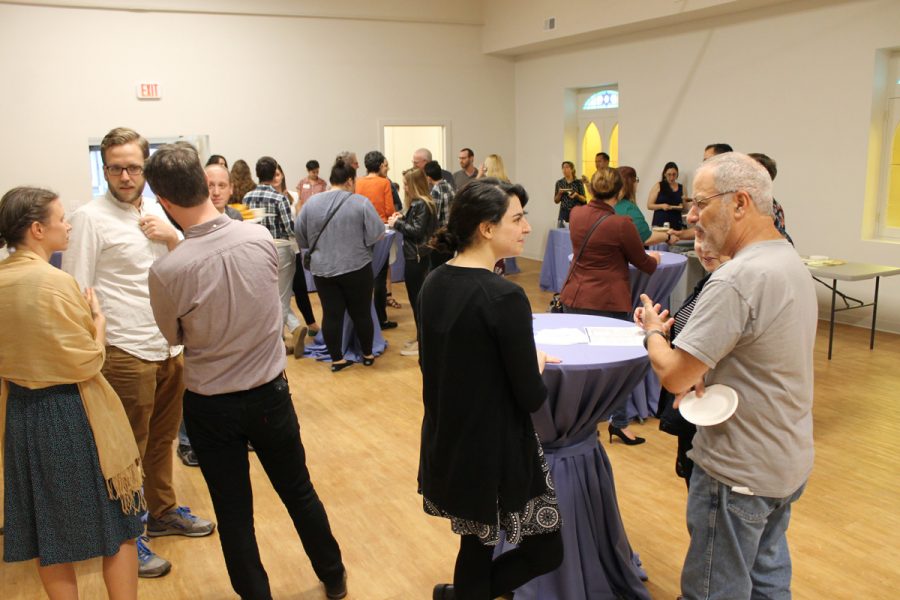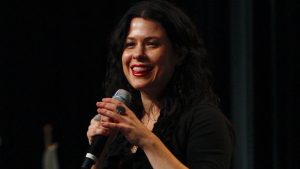Long-forgotten synagogue revived as center for Jewish life in the city
Published October 11, 2018
A few years ago, Paul Sorenson and his wife, Katie Garland, were walking through the Botanical Heights neighborhood when Sorenson spotted a building with Stars of David etched in stone on the brick facade and in stained glass windows. Sorenson had heard about an old, vacant synagogue in the neighborhood, and it turned out they had stumbled upon it.
He asked the developers he eventually bought a home from about the synagogue. They told him they had purchased the building and were looking for a tenant.
“We said, ‘Hold on a second; we’ll get back to you.’ And that’s when we pulled the team together and started our conversation with” Jewish Federation of St. Louis, Sorenson recalls.
That discussion led to MaTovu, a Jewish center at 4200 Blaine Ave., which opened on Oct. 5.
The founders of the organization aim to provide what they say is a necessary piece of infrastructure for the growing number of millennial Jews who have moved to the surrounding communities in recent years.
“It took me a long time to really be able to connect to and find a Jewish community,” said Andrew Warshauer, a MaTovu founder from Indianapolis who attended Washington University and then moved to south St. Louis. “I like the area a lot and intend to stay and live in the city. I intend to live Jewishly, so I want to make sure (the Jewish community) is as accessible and vibrant in the city as it is in the county.”
A neighborhood in transition
When Sorenson, 32, and others first entered the building, some of the red walls were falling apart, wires were exposed and it smelled like mold, he said. There were also still chairs arranged as though for a service and a cross hung on one of the walls.
The 2,600 square foot building had last been used as a synagogue in 1944, according to the book “Zion in the Valley: the Jewish Community of St. Louis.” The Orthodox congregation had variously been listed under names such as “South Side Hebrew Congregation” and “Congregation Tipheris Israel.” In 1944, the group sold the building to Unity Temple, and it had been used for Christian services ever since.
Meanwhile, the surrounding neighborhood, formerly known as McRee Town, became riddled with crime, drugs and abandoned houses. But in 2010, Urban Improvement Construction (UIC), the developer of Sorenson and Garland’s house, and Central Design Office invested $20 million in the neighborhood, according to the St. Louis Post-Dispatch.
It now features popular restaurants such as Olio and a successful charter school, City Garden Montessori.
Sorenson said they liked the neighborhood because it was a “diverse community full of a lot of young people as well as folks who had been there for a long time, and there was stuff to walk to,” like the charter school.
He is not alone among young Jews who like living in the city.
Ashreinu, a community of mostly Jewish millennials, rotates among various participants’ homes in the city for Shabbat services, Jewish learning and sessions singing nigunim (melodies). A number of the Ashreinu organizers were also founders of MaTovu, and the group will sometimes use the space. As will B’Yachad, a similar group organized by Reform rabbis that rotates for services among different spaces.
Chabad, a Jewish outreach organization, also plans to open a center in the Central West End.
But MaTovu does not plan to hire a rabbi or function as a synagogue, the founders said.
“We envision this space to be a resource for the entire Jewish community. We want to partner with all of the different synagogues and rabbis and do programming that is religious, spiritual and cultural,” said Warshauer, 29, who also works as a marketing manager for the Kranzberg Arts Foundation.
Jewish Federation provided the six founders with $30,000 for the space; the Staenberg Family Foundation provided $3,600; and a third Jewish network provided $4,000, according to Sorenson.
UIC had purchased the building in 2015 from the Blaine Avenue Church of God for $60,000, according to the firm. They have since invested $400,000 in the property and will receive $125,000 in tax credits. The firm still owns the building and leased it to MaTovu for three years, with an option to renew.
“A lot of times, what happens with any kind of religious buildings” during a redevelopment of a neighborhood block “is they get converted into residential space or some other adaptive reuse,” said Brent Crittenden, CEO of UIC. “In this case, we were just fortunate to find a use that was allied with the original function of the building.”
A building with many purposes
In addition to services, MaTovu will be used for meals, art, classes, concerts and private events. Organizers expect to host three to four events each week. And they plan to hire a part-time program and engagement manager.
At the open house, a mix of people — old and young, Jewish and non-Jewish — filtered in and out of the building and left notes on a poster asking, “What do you want to see in this space?”
Amy Hilgemann, president of the Botanical Heights Neighborhood Association, said she and other neighbors had been watching “all the construction with a lot of anticipation.”
She has lived in the neighborhood since 1976 and recalls a time there when it was largely “empty lots and empty buildings,” and “the crime was horrendous; we had gangs; there was crack, cocaine.”
Now in the midst of a rebound, Hilgemann describes Botanical Heights “as one of the most diverse neighborhoods in the city” where “people are very friendly and talk to one another.”
MaTovu “adds an awareness about the Jewish culture and the Jewish community, and I think that’s great,” said Hilgemann, who is not Jewish.
A story continues
To say that the Blaine building had not been used as a Jewish space since 1944 is not entirely accurate. In 1999, a Christian pastor reached out to Rabbi James Goodman because his congregation had just moved in, and the pastor thought it looked like a synagogue. Goodman, then of Congregation Neve Shalom, met him at the building and looked at where the Torah ark had been, among other indications of the former congregation. He said he “felt a sense of the souls that prayed there.”
Goodman asked if he could bring his congregation to pray in the space “once more.” So the clergymen held a Selichot service before Rosh Hashanah with the two communities.
Goodman also wrote a story about the synagogue that he used in an art exhibit displayed at a museum in Detroit.
And he thought that would be the end of it. But then about a year ago, he heard that a group of young Jews were “cleaning out” an old synagogue on Blaine and he said, “I know that space.”
Goodman, also a musician, and the Brothers Lazaroff will play a concert at MaTovu on Saturday, Nov. 10.
“It violates my own expectations,” he said. “I thought the story was over, and it’s delightful for me that the story is not over.”















